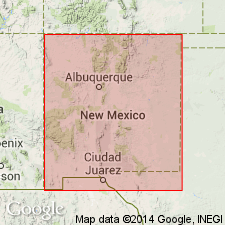
- Usage in publication:
-
- Grande limestone
- Modifications:
-
- First used
- Dominant lithology:
-
- Limestone
- Chert
- AAPG geologic province:
-
- Orogrande basin
Summary:
First used; intent to name not stated, and no type locality designated. Area of report is Lake Valley region, Sierra Co, NM in Orogrande basin. All of the Lake Valley silver ores are found in this formation. They were first recognized at the Sierra Grande mine workings. Exposed in a section at Lake Valley, where it overlies the Berenda limestone and underlies Lake Valley limestone. At base of formation is a massive, hard, grayish-blue coralline lime-rock, from 13-15 ft thick. Above this is 2 ft of black, subcrystalline limestone, carrying abundant large corals and gastropods. The upper member, 10 ft thick, consists of blue, compact, heavily bedded, pure soluble lime-rock, with but few fossils. Above permanent water level this formation is usually more or less cavernous. Much massive chert is also accumulated in the old caverns and crevices. Grande limestone terrane appears to correspond to Chouteau limestone of the standard Mississippi Valley section. Is of Carboniferous age. Cross sections, geologic section.
Source: GNU records (USGS DDS-6; Denver GNULEX).
For more information, please contact Nancy Stamm, Geologic Names Committee Secretary.
Asterisk (*) indicates published by U.S. Geological Survey authors.
"No current usage" (†) implies that a name has been abandoned or has fallen into disuse. Former usage and, if known, replacement name given in parentheses ( ).
Slash (/) indicates name conflicts with nomenclatural guidelines (CSN, 1933; ACSN, 1961, 1970; NACSN, 1983, 2005, 2021). May be explained within brackets ([ ]).

